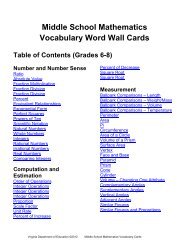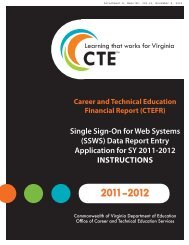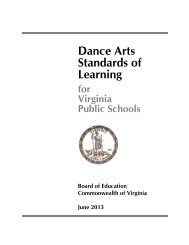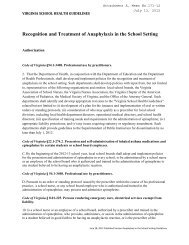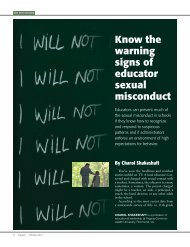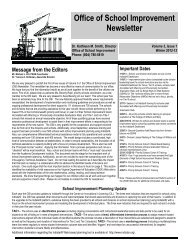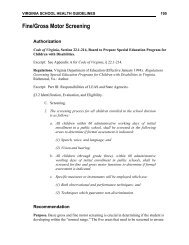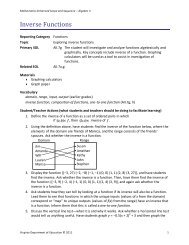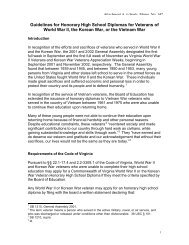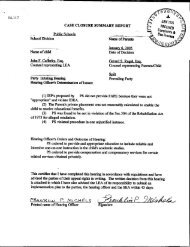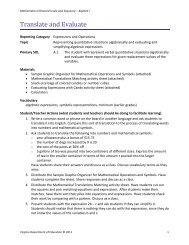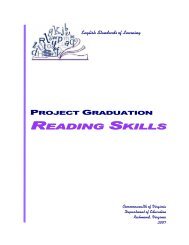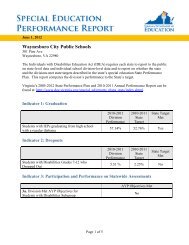What Makes Something Alive - Virginia Department of Education
What Makes Something Alive - Virginia Department of Education
What Makes Something Alive - Virginia Department of Education
Create successful ePaper yourself
Turn your PDF publications into a flip-book with our unique Google optimized e-Paper software.
Appendix A - Student Project Information<br />
Teacher Directions for the Student Team Projects<br />
Throughout the unit, students will be working in teams <strong>of</strong> three to four students to create a culminating project.<br />
This project is to be completed at school. Each team will select one <strong>Virginia</strong> animal to research. The final<br />
products from the student teams will include: a presentation about their animals to be given to the class, a<br />
visual product to be displayed, and a written report about their animals. The three final products will include<br />
information about the animal, its habitat, life cycle, adaptations, and its place within a food chain.<br />
Assigning the Project:<br />
Before beginning the <strong>Virginia</strong> Animals and their Habitats unit, you need to place your students in<br />
teams <strong>of</strong> three to four students. Use your discretion to assign teams. Students will work in these teams<br />
for their projects throughout the unit. The project is to be completed at school, not at home.<br />
Materials:<br />
Examine the list <strong>of</strong> <strong>Virginia</strong> animals ahead <strong>of</strong> time and gather a variety <strong>of</strong> books from your classroom<br />
and school library that students can use during their research. When appropriate, utilize your science<br />
textbook and grade-level resources. If your school has a science lead teacher, he/she would be an<br />
excellent resource. The intent is for you to use the resources your school has available.<br />
You may want to bookmark Web sites about <strong>Virginia</strong> animals for your students ahead <strong>of</strong> time so that<br />
they will be able to easily access data about their team animals from the Internet.<br />
The Design Brief is included in Appendix A and is an overview <strong>of</strong> the components <strong>of</strong> the project. It is<br />
to be utilized as a checklist to make sure that each student team has all <strong>of</strong> the required elements for<br />
their projects. When you introduce the project to the student teams, go over the Design Brief with<br />
them.<br />
You have been provided a rubric for each section <strong>of</strong> the project. You will need to preview these ahead<br />
<strong>of</strong> time so that you know the student team expectations for each part <strong>of</strong> the project. These will be<br />
given to student teams at different times during the unit and discussed with them so that they<br />
understand the expectations for their project‟s culminating products. Each student team should keep<br />
the Design Brief and the rubrics in their team notebooks so they can refer to them as they are working.<br />
Logistics<br />
Time has been built in throughout the unit for students to work on the different components <strong>of</strong> their<br />
team projects during class time. Additional class time can be added if needed. At the end <strong>of</strong> the unit,<br />
each team will combine all the pieces they have been working on and put them together into the final<br />
project products – the presentation, the visual product, and the written report. The intent is not for<br />
the student teams to do the project all at once!<br />
You will have many roles throughout the unit. Your instruction will give students the content and<br />
tools necessary to complete each aspect <strong>of</strong> the project. You will monitor each student team‟s<br />
progress throughout the unit. At the end <strong>of</strong> the unit, you will facilitate the analysis <strong>of</strong> the cumulative<br />
information gathered and given during the unit. You will also help students to develop group<br />
statements on the key concepts <strong>of</strong> interdependency and conservation within <strong>Virginia</strong>‟s ecosystems.<br />
234<br />
<strong>Virginia</strong> Animals and their Habitats<br />
Student Team Project Documents<br />
Teacher Directions for the Student Team Projects



